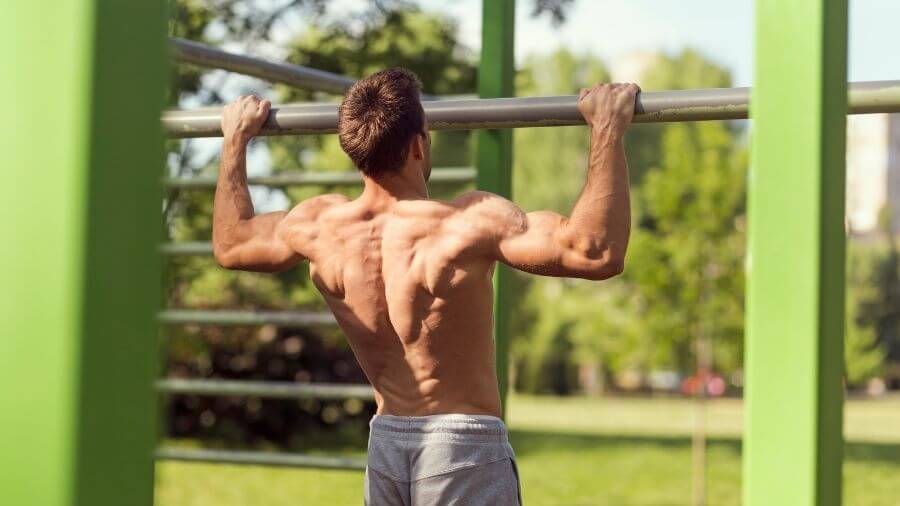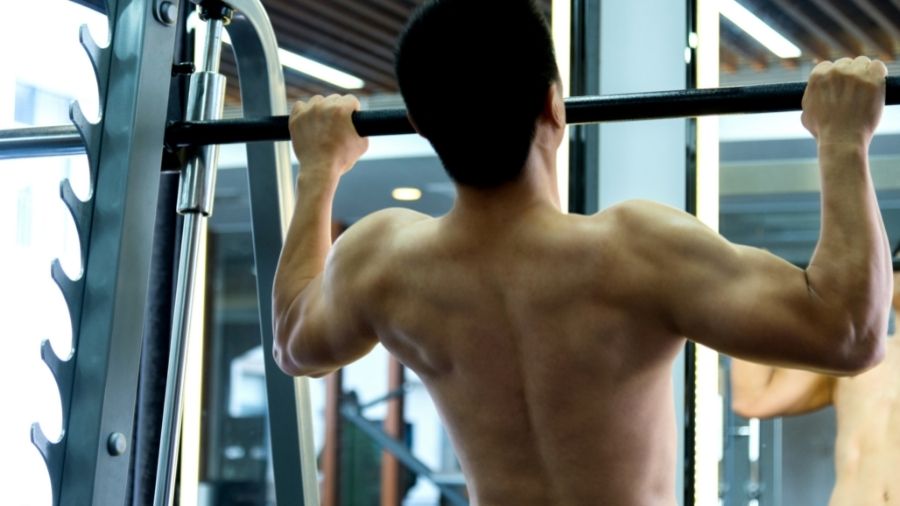Sitting in the gym with sweat running down your face, you’re staring at your program, wondering why your next exercise is called a chin-up, yet last week it was called a pull-up? Let me bust your confusion!
The only difference between the chin-up vs. pull-up is the hand position. The chin-up uses a supinated grip (palms toward you), while the pull-up uses a pronated grip (palms away).
But that doesn’t cover all the differences between the chin-up and pull-up. You may be surprised why you should use one over the other.
Table of Contents
- What Is A Chin-Up?
- How To Do A Chin-Up
- What Muscles Does The Chin-Up Work?
- What Is A Pull-Up?
- How To Do A Pull-Up
- What Muscles Does The Pull-Up Work?
- Chin-Up vs. Pull-Up Benefits
- Chin-Up vs. Pull-Up For Beginners
- Chin-Up vs. Pull-Up Which Is Harder?
- Chin-Up vs. Pull-Up Which Is Better?
- Chin-Up vs. Pull-Up Frequently Asked Questions
- Summary
What Is A Chin-Up?
A chin-up is the king of upper body pulling exercises—no need for fancy equipment. The chin-up requires only your bodyweight and a bar to hang from. If you want to take it to the extreme, you can use large tree branches to hang from.
Since you can’t grip the branch as it’s too thick, you’ll challenge your grip and forearms for added difficulty. It is one of the best exercises for building a wide back. So, how do you do it?
How To Do A Chin-Up
Find yourself a bar to hang from and use this step by step for the perfect chin-up:
- Grip the bar with your palms toward you, known as a supinated or underhand grip.
- Create a big chest from the dead hang position like you’re trying to face your upper chest to the chin-up bar.
- Pull yourself up by driving your elbows to your ribs while maintaining a big chest.
- If you’re strong enough, your chest should touch the chin-up bar.
- Slowly lower yourself back to the dead hang position.
It’s as simple as that. One common mistake is lifters won’t maintain a big chest creating a rounded upper back posture. You will struggle to activate your lats in this position, turning it into a biceps exercise instead of a back exercise.
The chin-up has another grip variation called the neutral grip chin-up. This is known as a parallel grip where the palms face each other where you will be strongest in this grip position. It is an excellent alternative to the underhand chin-up, especially if it causes wrist or elbow pain.
What Muscles Does The Chin-Up Work?
The chin-up primarily works the lats. The large muscles that run down the side of your back. However, since the arm is supinated, the biceps are in an advantageous position to help with the exercise. Making the chin-up an excellent biceps exercise too.
What Is A Pull-Up?
Just like a chin-up, the pull-up also involves pulling yourself to the bar from a hanging position. But this time, with palms facing away from you. This is known as a pronated or overhead grip. The pull-up is a staple upper body strength test often used in military and professional sports teams.
How To Do A Pull-Up
Here is how to do a perfect pull-up:
- Grip the bar with your palms facing away from you. A medium grip width is best for maximizing back development.
- Create a big chest from the dead hang position like you’re trying to face your upper chest to the chin-up bar.
- Pull yourself up by driving your elbows to your ribs while maintaining a big chest.
- If you’re strong enough, your chest should touch the chin-up bar.
- Slowly lower yourself back to the dead hang position.
When setting your pull-up grip, I prefer using a false grip known as a thumb overgrip. In my experience, this reduces the involvement of the forearms and grip, so you can focus on targeting the lats.
Because the hands act like hooks, you don’t rely as much on your grip strength. Further, you can pull with your pinky and ring fingers giving you a better lat contraction.
What Muscles Does The Pull-Up Work?
The pull-up is the best exercise for building back muscle. Compared to any other back exercise, the pull-up is king for activating the lats [1]. The pull-up also works the biceps to a lesser extent than the chin-up since the biceps are in a disadvantageous position.
Chin-Up vs. Pull-Up Benefits

Here are seven powerful benefits when using the chin-up or pull-up in your workout routine.
Bigger Back And Arms
Have you ever seen someone who can rep out multiple chin-ups or pull-ups who doesn’t have a huge muscular back? Me neither. To perform the gold standard of 10 reps in one set, you need to have developed significant muscle of the lats and arms.
Develop Immense Upper Body Pulling Strength
If you participate in any grappling or collision sport, you’ll know the importance of pulling strength. Being able to grab another human being and take them down to the floor requires a strong upper body. Chin-ups and pull-ups are your tickets there.
But upper body pulling strength has more applications than just sport. It helps to balance out your physique as day-to-day activities happen with your arms in front of you. Training the back muscles provides structural integrity to the upper body, potentially reducing your risk of injury.
Push More Weight
Wait. What does pulling up to a bar have to do with bench or overhead pressing? A broader base to press from increases your stability and, therefore, will help you press more weight. The saying goes, “you can’t shoot a cannon from a canoe.”
If you imagine the canoe is your back, there is no stability when shooting the canon (pressing the weight). A broader, sturdier canoe will allow you to shoot a powerful canon.
Get A Stronger Grip
If you can’t hang from a bar, you won’t be able to pull yourself up. Pull-ups and chin-ups require a strong grip. One way to develop this is to pull up more often. Every time you hang from the bar, it’s extra reps for your grip and forearms.
You Can Do Them Almost Anywhere
Wherever there is somewhere to hang from, you can do pull-ups and chin-ups. They even make pull-up bars that hang on your doorway like this one below:
Just be aware that it can cause some damage to your doorway, so if you are renting, you may look for another option!
You Can Use High Volumes
Pull-ups and chin-ups are not like heavy deadlifts. There is only so much heavy deadlifting you can do before something breaks, or you’re in a hole of fatigue. But pulling yourself to a bar can be done for ultra-high volumes.
And I mean, ultra-high. Hundreds of reps per day are easily possible if you have a setup at home. One trick is to place a pull-up bar on your doorway so every time you walk past, you pump out a bunch of reps. The volume adds up throughout the day.
I would recommend varying your grip when doing this. Using the same grip for high volumes of work can lead to elbow or wrist pain.
Improve Shoulder Mobility
This is a lesser-known benefit of the pull-up and chin-up. It places a significant stretch on the lats and muscles deep in the shoulder when in the dead hang position. You’ll feel it create space in the shoulder that is relieving.
It’s an incredible stretch for those that need overhead mobility or shoulder relief and is not talked about enough.
Chin-Up vs. Pull-Up For Beginners

For beginners, I would recommend starting with the chin-up. Because the biceps can help, it is easier for beginners to get their first rep. As you get stronger and can easily get five or more chin-ups, incorporate pull-ups as well. This way, you develop strength in all grip positions.
Chin-Up vs. Pull-Up Which Is Harder?
The pull-up is more challenging than the chin-up because the biceps are in a disadvantageous position, so they cannot contribute to the same extent compared to the chin-up. From my experience, the neutral grip chin-up is the easiest of all.
The parallel grip places you in the perfect position to use the powerful brachialis muscle of the arm. Have you realized you can curl much more during a hammer curl than a palm up bicep curl? The strong brachialis is the reason why.
Chin-Up vs. Pull-Up Which Is Better?
Which is better depends on your goal. If your goal is to build a massive back, the pull-up is better. If your goal is to develop your biceps and your back, then the chin-up is better. But there is no reason you can’t do both!
I love to vary my grips when doing pull-ups and chin-ups. Whether that is from set to set or workout to workout, I’ll use a variety of grips and grip widths to be strong in every position.
Chin-Up vs. Pull-Up Frequently Asked Questions

Are Chin-Ups Easier Than Pull-Ups?
Chin-ups are easier than pull-ups because of the increased contributions from the biceps. This comes at the cost of reduced lat involvement in the chin-up compared to the pull-up.
How Many Chin-Ups Equal A Pull-Up?
If you can do three strict chin-ups, you will be able to do a strict pull-up. This may differ individually, so add or subtract one or two reps.
How Many Chin-Ups Is Good?
How many chin-ups is good will depend on your goal. If you need to meet a fitness test standard, that number is considered good. But if you are doing chin-ups for physique or physical activity goals, ten chin-ups is treated as the gold standard of upper body strength.
Do Chin-Ups Work Abs?
Chin-ups do work your abs. Is it going to build thick blocks of muscle on your abdominal wall? Probably not. But strict chin-ups do activate the abdominal muscles. You can take this a step further and hold your legs in an L position to increase the involvement of the abs during the chin-up.
Do Chin-Ups Work Biceps?
Chin-ups do work the biceps much more than the pull-up. It makes a great addition to an arm workout. Start with weighted chin-ups before blasting your biceps with various isolation exercises, and you’ll see a significant gain in muscle growth.
How Do I Get Better At Pull-Ups?
The number one way to get better at pull-ups is to do more of them. A lot more. I have a complete guide on how to get better at pull-ups here.
Summary
The chin-up vs. pull-up debate shouldn’t exist in my experience. You must do both! However, you may prioritize the pull-up when maximizing back development and prioritizing the chin-up when looking to add mass to the arms.
References
1. Hewit, J. K., Jaffe, D. A., & Crowder, T. (2018). A comparison of muscle activation during the pull-up and three alternative pulling exercises. J. Phys. Fitness, Med. Treat. Sport, 5(4), 1-7.
